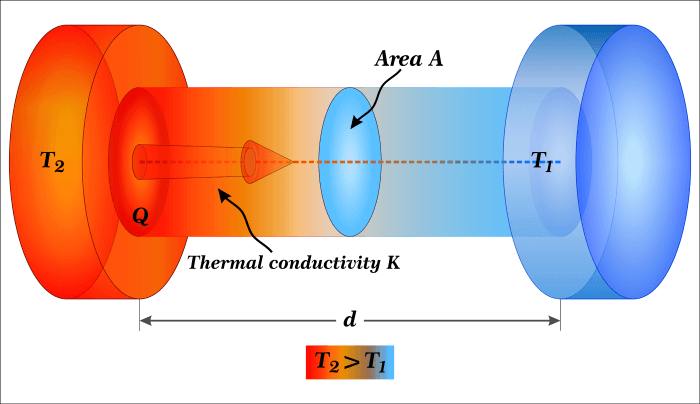What is Thermal Conductivity? Explanation, Measurement, Uses

Thermal conductivity is a fundamental concept in heat transfer and is crucial in multiple industries and scientific disciplines. It refers to the ability of a material to conduct heat or the rate at which heat transfers through a substance. Understanding this property is essential for designing efficient thermal systems, optimizing energy usage, and ensuring the safety and performance of various materials and products.
Learn about other thermal coating properties like glass transition temperature and linear coefficient of expansion
Understanding heat and its relationship to thermal conductivity is essential in grasping the concepts of heat transfer. Heat, in its simplest form, transfers energy from one object to another due to temperature differences.
Temperature gradient plays a significant role. A temperature gradient refers to the difference in temperature between two points in a material or between two adjacent materials. Heat transfer occurs when there is a temperature gradient, with heat flowing from regions of higher temperature to regions of lower temperature.
This phenomenon is driven by the basic principle of nature - the tendency of a system to seek equilibrium. When there is a temperature difference, the system will naturally attempt to balance the temperatures, leading to heat transfer and thermal conductivity.
The Physics Behind Thermal Conductivity
Thermal conductivity is a fascinating concept deeply rooted in the fundamental principles of physics. At its core, thermal conductivity is defined as the ability of a material to conduct heat. This ability is determined by various physical factors that govern the flow of heat energy.
The mechanisms of heat conduction can explain this property at the molecular level. Heat conduction occurs when a temperature is different between two points in a material. In simple terms, it is the movement of heat energy from higher-temperature to lower-temperature regions.
One of the fundamental relayed principles is the concept of thermal resistivity. This refers to a material's resistance to the flow of heat. Materials with lower thermal resistivity have higher thermal conductivity, allowing heat to be transferred more easily.
Another essential principle is the role of atomic and molecular interactions. Heat energy is transferred through these interactions as atoms or molecules collide and exchange kinetic energy. A material's structure and arrangement of atoms or molecules can greatly impact its values.
Measurement Techniques
Measurement techniques are crucial in providing accurate data to understand thermal conductivity. Various experimental methods have been developed to measure thermal conductivity, each with advantages and limitations.
Overview of Experimental Methods
Experimental methods for measuring involve subjecting the material to controlled thermal conditions and observing the resulting heat transfer. These methods can be broadly classified into steady-state and transient techniques.
- Steady-State Heat Flow: This method involves establishing a steady-state heat flux through the material and measuring the temperature gradient. Knowing the sample's dimensions and the temperature difference, the value can be calculated using Fourier's Law of heat conduction.
- Transient Hot Wire Method: A thin wire with a known value is placed in contact with the material in this technique. A constant heat flux is applied to the wire, and the temperature rise is measured. By analyzing the rate of temperature change, thermal conductivity can be determined.
- Laser Flash Analysis: Laser flash analysis is commonly used to measure thermal conductivity in solids. This method applies a short pulse of laser light to one end of the sample, creating an instantaneous temperature rise. The temperature decay is then measured and analyzed to calculate the value.
Non-Destructive Testing Techniques
Non-destructive testing techniques are commonly employed when measurements must be taken on finished products or structures without altering their integrity. These methods offer convenience and allow for thermal conductivity measurements in real-world applications.
Some non-destructive testing techniques commonly used for measuring thermal conductivity include infrared thermography, ultrasound, and thermal wave analysis. These techniques utilize the principles of heat transfer and allow for non-intrusive measurement of thermal conductivity in various materials.
Applications of Thermal Conductivity
The concept of thermal conductivity is essential in designing and optimizing thermal insulation materials to reduce heat loss or gain. It is also pivotal in developing efficient heat exchangers, such as those used in HVAC systems, refrigeration units, and power plants.
Additionally, it is a key factor in determining the performance and efficiency of electronic devices, such as computer processors and power electronics. Optimizing this value helps dissipate heat generated by these devices, preventing overheating and ensuring longevity.
Here are some examples of the wide-ranging applications of thermal conductivity:
- Designing heat sinks for electronic devices: This property helps dissipate heat generated by components, ensuring optimal performance and preventing overheating.
- Energy recovery systems: Energy recovery systems aim to capture and utilize waste heat generated by industrial processes. By efficiently transferring heat, it enables the conversion of waste heat into usable energy, reducing energy consumption and costs.
- Enhancing thermal management in engineering applications: The property helps design and optimize cooling systems, ensuring efficient heat dissipation and preventing equipment failure due to overheating.
Due to the importance of this material property, selecting a protective coating material with the most suitable value is paramount. Please get in touch with us if you are a design engineer and have questions about protective coatings for electronic components. Otherwise, learn more about protective coating protection properties, such as optical properties like refractive index and transparency.
Biocompatible Coatings - Coating Techniques, Applications, More
UL94 Coating Material - Testing Method, Material Selection
Dielectric Constant of Insulator Materials: Formula, Table of Values
Mallory is a veteran writer with over a decade of writing experience and has spent over five years at HZO learning about coating technology from the best minds in the industry. Professionally, Mallory is especially interested in the process of problem-solving and watching how the engineering team develops solutions that ensure business requirements are met. Over her years at HZO, Mallory's writing has been cited in industry whitepapers, including "Parabolic Model for Optimum Dry Film Thickness (DFT) of Corrosion Protective Coatings" and "Universal Approach to Integrating Reduced Graphene Oxide into Polymer Electronics." All of Mallory’s blogs are reviewed for accuracy before publication.
Additional Resources

Understand the Capabilities of Thin Film Coatings With Our Resource Page

Understand UL94 Rating - Testing, How to Choose a Material, and More

What's the Difference Between Hydrophobic Coatings and Hydrophilic Coatings?

Dielectric Constant of Insulator - Materials, Formula, Table of Values

Tensile Strength at Yield - Testing, Definition, Material Selection

Young's Modulus of Polymers - Measurement, Calculation, Material Selection

Volume Resistivity - Definition, Measurement, Implications For Product Design

Polymer Glass Transition Temperature – Material Properties, Impact

What is Coefficient of Linear Expansion? Formula, Units & More

Learn About the Thin Film Coating Properties and Processes In Our Webinar

The Difference Between "Hydrophilic and Hydrophobic" Coating Properties

Learn about Protective Coating Methodologies With Our White Paper























